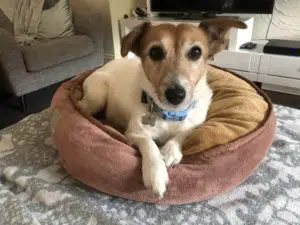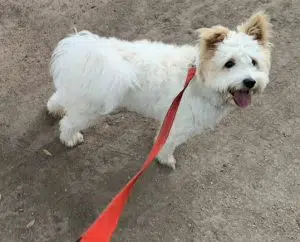
Anxiety is VERY common in our beloved dogs yet many people miss many signs of anxiety in dogs and truly don’t understand why or how it occurs. In fact, according to a recent large-scale study, up to 70% of dogs are showing signs of anxiety.
Anxiety happens when your dog experiences fearful thoughts and feelings which then trigger or cause a state of physiological arousal – in which adrenaline levels increase. Your dog’s fear response can be triggered by a broad range of different stimuli – sounds, smells, situations, other people or other animals, dogs, etc.
Anxiety causses an elevated heart rate, decreased gut activity, increased sensory sensitivity, increased alertness (hypervigilance), and a range of behaviours (symptoms) that can help you identify the signs of anxiety in dogs including:
Anxiety is an unhealthy, inappropriate, ‘stuck on’ expression of a deep, genetically hard-wired survival instinct, often called the Fight/Flight response.
Anxiety can be triggered by many different things (the sizzle of a barbeque, loud noises, moving objects and many more examples) that pose no threat or danger.
However, your anxious dog thinks and feels that these things are life-threatening. Anxiety is EXTREMELY distressing and debilitating for dogs, so you need to take this seriously and always be on the look out for signs of anxiety in dogs.
The sooner you can spot the early signs of anxiety in your dogs, the sooner you can act to prevent and treat your dog’s anxiety. The earlier you act, the easier it is to help your dog and the better outcomes you are likely to see. The longer you leave anxiety, the worse it gets, and the harder it is to treat.
Anxiety is a multifactorial disease, usually with many causes over a long period of time. Many dogs will start with only one kind of mild anxiety (for example noise sensitivity) and over time get worse, and add in other kinds of anxiety like separation anxiety, reactivity, etc.
There are fairly consistent changes in body language, or non-verbal communication in dogs who are experiencing anxiety. This is what to look out for:
The Four Faces of Anxiety in Dogs (and why two are easy to miss!)
There are four faces or expressions of anxiety in dogs. You need to know what all of them look like, so you’ll be sure to pick up any anxiety issues in your dogs as early as possible. Two of these you’ll probably know about, and at least one most people are surprised to learn is actually anxious behaviour.
The first face of anxiety is Fight. The fight face is easy to see – these dogs are reactive, lunging, barking, escalating to attacking and biting whoever or whatever thing they are afraid of. These dogs are trying to make the scary thing go away, by actively attacking it. It’s very easy to see. And dangerous for the dog and others!
The second face of anxiety is also easy to see – Flight. These dogs are trying to get away from the scary thing- in the vet clinic, they might be hiding under chairs. In a thunder storm, they might be jumping the fence and going into a blind bolt. They might dig or chew their way out of the house, jump fences, escape, hide under beds or in cupboards, etc.
The third face is harder to spot. This is the Freeze. These dogs can go totally still and silent, or they may have a partial freeze, which means that they’ll be shut-down to some extent. This one is easier to miss.
Many people misinterpret this stillness as a dog who is relaxed and ok. However, if you observe closely you’ll notice that there is a tension in the stillness. This is not a happy dog. The dog will often be less responsive or unresponsive to communication when they are in a freeze.
The fourth face of anxiety in dogs is the one that is very commonly misunderstood, misinterpreted, and missed. This is the Fidget.
These dogs get into heightened states of arousal and become over-excited. Not only that, they often stop responding to commands from their humans. This is the classic dog who when people come to visit, is out of control, jumping all over everyone, non-responsive to commands, and a total pork chop!
The higher the level of unhealthy arousal, the less cognitive capacity an anxious dog has, By the time they cross their arousal ‘red line’, your anxious dog literally cannot understand or respond to your communication.
Many people think that the fidget face of anxiety in dogs is a happy, playful dog. In reality, this is a distressed, anxious dog who is uncomfortable, unable to regulate into healthy relaxation, and in need of help from you, the human.
If you want to learn a simple, highly effective relaxing bodywork that can take anxious dogs from chronic distress, and distressing symptoms of anxiety (that cause serious harm over time), you might like ot consider learning the Whole Energy Body Balance™ Method with ‘The Healing Vet’ Dr Edward Bassingthwaighte.
You’ll learn bodywork skills that trigger a deep, powerful body-level relaxation response. Most of his students see improvement sin their anxious dogs within 2-4 weeks, studying and practicing 1-2 hours each week. And it’s totally safe.
You can learn more, and regiSter for his FREE MASTERCLASS at www.wholeenergybodybalance.com

The role of moisture in dog food



Walking a dog – how much and why

Tips for exercising a dog indoors


Get your paws on Lara Shannon’s best selling books ‘Eat, Play, Love (your dog) and World of Dogs.
Available in Australia, USA, UK and Canada.